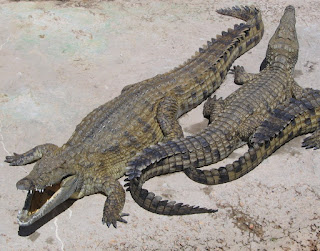 Facts About The Crocodile
Facts About The CrocodileThe largest crocodile species is saltwater crocodile (Crocodylus porosus), encountered from India to northern Australia and Fiji. In can reach 7 m (23 ft) in length and 1 tonne in weight! At 5 m (17 ft) length, it already has 0.5 tonne!
Even so, a crocodile egg is no larger than that of a goose!
The smallest crocodile is the dwarf crocodile (Osteolaemus tetraspis) from central Africa, which has a maximum length of 1.9 m (6.5 ft). It is more terrestrial than other crocodiles.
To "cry crocodile tears" is a common expression which is used for depicting fake sadness. It has its origins in the myth according to which reptiles weep while eating humans. But, believe it or not, crocodiles really do wipe while feasting, but rather due to physiological reasons than remorse. Their eyes can froth and bubble during the feeding. Air pushed through the sinuses could mix with tears in the animal's lacrimal (tear) glands and the whole content could be emptied into the eye; resulting the "fake" remorse.
Crocodile skin is considered one of the finest and best, being soft and durable. In many tribal societies, skin crocodile is used as a symbol of high status. But only the skin on the belly has these qualities; the back skin is covered in bones (called osteoderms) that reflects arrows, spears and even bullets!
A crocodile skin purse can cost $ 15,000. The value of the crocodile skin has been fueling an intense poaching and today many of the 23 species of crocodiles and relatives are threatened, many populations being wiped out. The salvation of the crocodiles could come from the crocodile farms.
Brazilian poachers capture caymans during the night, by thrusting spears between their eyes (which can be easily spotted night, due to the shiny tapetum layer). The animals are brought into the boats and skinned alive.
In the case of Australian Aborigines, some tribes were expert in crocodile hunt, while for others the crocodile hunt was taboo.
Crocodiles display increased aggressiveness during the mating season (linked to the monsoon).
Each crocodile jaw carries 24 sharp teeth meant to grasp and crush, not to chew. That's why they swallow stones that grind the food inside their stomachs (the stomach stones also serve as ballast). The teeth are continuously replaced along the crocodile's life. Crocodiles can exert enormous pressure when closing their jaws, but the force for opening them is so weak, that an adhesive band is enough to keep a large crocodiles' jaw shut up. The powerful jaws can be extremely delicate, working like pencils, when removing offspring from the nest. Still, beware at the tail: it inflicts powerful blows.
Many times crocodiles stay on the river banks mouth wide open. That is not an aggressive posture, but a way to cool off: they sweat through the mouth!
The crocodiles have a four-chambered heart like in birds (their closest relatives) and mammals, for an active life. Still, when diving, the heart behaves like a three-chambered reptilian heart, enabling them to stay more underwater.
How can you make the difference between a crocodile and an alligator? If you are not accustomed to their shape, look at the mouth: crocodiles have a clearly visible the fourth tooth on the lower jaw even when the mouth is closed (alligators and caymans have a groove where that tooth fits). Because crocodiles have salt glands inside their mouths they can stand sea water, while alligators cannot. That's why many crocodiles species abound in mangroves and estuaries. Behaviorally, crocodiles are more active and more aggressive than alligators, and also less resistant to cold (alligators are found in subtropical areas, crocodiles not).
If you turn on a lantern at night in waters populated by crocodiles, you will see pairs of shiny red dots. These are the crocodiles' eyes which have a layer called tapetum behind their retina, containing crystals that reflect light and make possible the night vision.
99% of the crocodile offspring are eaten in the fist year of life by large fish, monitor lizards, herons and ... adult crocodiles. During the first weeks of life, the crocodile offspring eats the food reserves from its viteline sack. The crocodile eggs are appreciated by monitor lizards, hyenas, large storks and even... humans. A female lays 20-80 eggs which are incubated in a nest built from plant materials and defended by her for three months.
A farmed crocodile reaches 1.5 m (5 ft) in length in just one year. In the wild, without such a constant food supply, it requires 3 years to reach the same length.
Crocodiles can swim just with the help of their powerful tail with 40 km (25 mi) per hour, and can stand underwater 2-3 hours. On land they can burst on short rapid races, but they get tired very quickly. They can also execute jumps out of the water, a several meters long.
The first crocodiles appeared 240 million years ago, at the same time with the dinosaurs (to which they are related), had less than 1 m (3 ft) in length and ran on two feet! That's why even today, crocodiles have longer hind limbs than fore limbs.
Crocodiles can live up to 80 years!
For more information:http://www.sunriseafricasafaris.com/index.php
For reservations:tours@sunriseafricasafaris.com
Tours in Nairobi Kenya with Sunrise Tours & Safaris:http://sunriseafricasafaris.blogspot.com
Follow us on Skype:sunriseafricasafaris
No comments:
Post a Comment